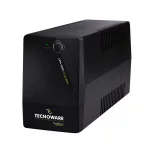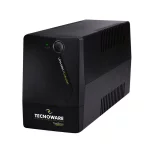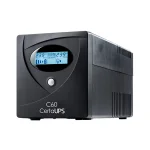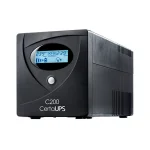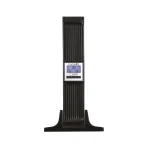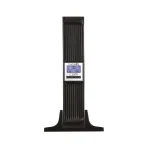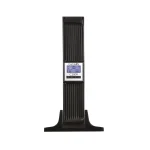Edge computing pushes data processing nearest to the device that needs the information to operate, rather than pushing the data back to a centralised datacentre. Edge computing is essentially a de-centralised approach. In terms of power protection to ensure resilience in an entire decentralised eco-system it is important to protect both the servers within the cloud datacentre and each data-processing point along the Edge computing network. Larger three phase UPS systems may be required for datacentres with far smaller uninterruptible power supplies required for small load servers, PCs and Internet of Things (IoT) devices.
UPS Sizing
Uninterruptible power supplies (UPS) are typically sized in VA or kVA (1000VA) and have a corresponding Watts (or KW) rating. The relationship between VA and Watts is known as the Power Factor. When VA equals Watts, the Power Factor is 1, referred to as Unity Power Factor. For more information on UPS sizing calculations and formulae, please refer to the section below or contact us for assistance with battery backup size calculator, UPS battery runtime calculator, or UPS sizing guide. Whether you need to calculate UPS for PC, size my UPS, or find the right UPS battery size, our tools and experts can help you with sizing a UPS battery backup and determining the correct UPS sizes in kVA.
- UPS Systems (716)
- UPS Solutions (713)
- UPS Technologies (699)
- Power Distribution (333)
- Backup Power (458)
How to Calculate VA for a UPS System
See our quick lookup UPS VA, Amps and Watts sizing table for single-phase UPS up to 10kVA.
Most UPS systems are sized according to VA or kVA (where 1000VA = 1kVA). VA is referred to as the ‘Apparent Power’ drawn by an electrical load. VA is calculated by multiplying the RMS supply Voltage (V) by the load current draw Amps (A).
Apparent Power (VA) = Volts (V) x Amps (A)
In the UK and Europe the standard mains power supply voltage (single phase) is 230Vac. If the current drawn by a load is 2A, the VA value is:
Apparent Power (VA) = 230 (V) x 2 (A) = 460VA
For this load the nearest UPS size would be a 500VA, 600VA, 750VA or 800VA UPS system. It is recommended good practice to allow for future load expansion and to size a UPS with at least a 20% head room between the load VA and capacity of the UPS.
To calculate the three-phase mains power supply load size, the UPS sizing calculation consists of measuring the Amps drawn per phase and calculating the Apparent Power per phase and then adding these together.
Three phase Apparent Power = kVA Phase 1 + kVA Phase 2 + kVA Phase 3
In addition to leaving a 20% headroom it is also considered good practice to balance the loads across the three phases. Unbalanced loads can lead to lower UPS operating efficiencies and phase conductor overheating.
If the calculated load per phase = 10kVA Phase 1, 8kva Phase 2 and 7kVA Phase 3, the UPS system loads would be fairly well balanced. The overall three phase UPS size required would be 25kVA with the nearest model typically being a 30kVA UPS. For a 20% headroom and additional capacity a 40kVA UPS system would be recommended.
Note that three phase UPS are typically sized in kVA or for larger systems (mega data centre sized) the term MVA is used. UPS systems can also be calculated in Watts, kW or MW.
Calculating a UPS System Real Power Rating – Watts (W)
The Watt rating of a load is measured in Watts and this number is used to size batteries for a load size and runtime. Watts is a typical measurement for linear resistive loads and can be calculated as:
Real Power (W) = Amps (A) x Volts (V).
Electronic equipment such as computers and servers use Switch Mode Power Supplies (SMPS) to convert the incoming AC (alternating current) from the mains power supply to the levels of DC (direct current) required to power internal circuits. SMPS are capacitive and when sizing a larger UPS system it is important to take into considering the Real Power Watts.
The difference between Apparent Power and Real Power is known as the Power Factor. This is the degree to which the current and voltage waveforms are out of phase with one another.
Real Power (W) = Apparent Power (VA) x Power Factor (pF)
or
Apparent Power (VA) = Real Power (W) / Power Factor (pF)
UPS Sizing Checklist
When calculating the load to be powered by a UPS system and selecting the right sized mode for the application it is important to consider the following:
- Load size: measured in terms of Apparent Power and for larger UPS systems Real Power.
- Load type: capacitive, induction or resistive load.
- Load site: comms room, server room, datacentre, commercial or industrial sites.
- Load space: the space available for the UPS in terms of form factor – desktop, tower, floor standing, panel mounting or 19inch rack mount.
- Load classification: critical, essential or non-essential to decide which loads need to be powered during a power outage by the UPS system and which could be powered by a standby generator or allowed to drop.
- Mains power supply: single or three phase and distribution from UPS system to the load(s).
- Start-up loads: start-up / in-rush demands of loads and their duration which can last up to 100ms.
- Overloads: will the UPS system need to be an on-line with an automatic bypass and what is the UPS overload capacity.
- Headroom: 20% is considered standard safety.
- Future expansion: 25% is considered standard for future expansion.
- Battery backup and recharge time: the amount of battery runtime required and time allowed to recharge the batteries. The typical target is 80% within 24 hours.
- Battery type: the standard battery type is a sealed valve regulated lead acid (VRLA) but the application may call for lithium-ion (Li-ion) batteries capable of a higher number of more rapid charge/discharge cycles.
- Remote monitoring: will it be necessary to connect the UPS system to a local area network using SNMP or volt-free contacts, and/or to monitor remotely 24/7.
- UPS Bypass Switch: this is an external device built into the installation to allow the UPS to be safely powered down or removed without disruption to the connected loads.
- Air flow: it is important to leave adequate air flow around the UPS of at least 200mm. Most UPS systems draw air into their cases via the front of the UPS and exhaust through the rear via temperature variable cooling fans.
- Cooling: where the UPS is being used in a server rack or small room it is important to consider air temperature and how to reduce this to the required 20-25˚ required by the batteries.
- UPS Maintenance Contract: it is recommended that UPS above 5kVA are maintained at least once a year through a preventive maintenance visit. The maintenance contract should also provide a time dependent emergency call out facility.
Please contact us for further information or to arrange a UPS site survey.

Earn SRE points on all online purchases with double points on selected products





























